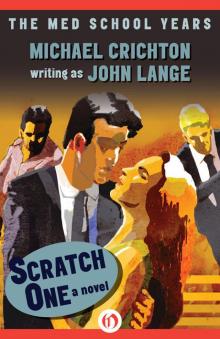- Home
- Michael Crichton
Five Patients Page 11
Five Patients Read online
Page 11
Page 11
And if, in this age of television, the surgeon shows more flamboyance than is scientifically necessary, more sense of drama than is medically indicated, he can at least be excused for upholding the traditions of his calling-and, in a deeper sense, the facts of his life.
Chapter 7
Sylvia Thompson. Medical Transition
Flight 404 from Los angeles to boston was somewhere over eastern Ohio when Mrs. Sylvia Thompson, a fifty-six-year-old mother of three, began to experience chest pain.
The pain was not severe, but it was persistent. After the aircraft landed, she asked an airline official if there was a doctor at the airport. He directed her to the Logan Airport Medical Station, at Gate 23, near the Eastern Airlines terminal.
Entering the waiting area, Mrs. Thompson told the secretary that she would like to see a doctor.
"Are you a passenger?" the secretary said.
"Yes," Mrs. Thompson said.
"What seems to be the matter?"
"I have a pain in my chest. "
"The doctor will see you in just a minute," the secretary said. "Please take a seat. "
Mrs. Thompson sat down. From her chair, she could look across the reception area to the computer console behind the secretary, and beyond to the small pharmacy and dispensary of the station. She could see three of the six nurses who run the station around the clock. It was now two in the afternoon, and the station was relatively quiet; earlier in the day a half dozen people had come in for yellow fever vaccinations, which are given every Tuesday and Saturday morning. But now the only other patient she could see was a young airplane mechanic who had cut his finger and was having it cleaned in the treatment room down the corridor.
A nurse came over and checked her blood pressure, pulse, and temperature, writing the information down on a slip of paper.
The door to the room nearest Mrs. Thompson was closed. From inside, she heard muffled voices. After several minutes, a stewardess came out and closed the door behind her. The stewardess arranged her next appointment with the secretary and left.
The secretary turned to Mrs. Thompson. "The doctor will talk with you now," she said, and led Mrs. Thompson into the room that the stewardess had just left.
It was pleasantly furnished with drapes and a carpet. There was an examining table and a chair; both faced a television console. Beneath the TV screen was a remote-control television camera. Over in another corner of the room was a portable camera on a rolling tripod. In still another comer, near the examining couch, was a large instrument console with gauges and dials.
"Youll be speaking with Dr. Murphy," the secretary said.
A nurse then came into the room and motioned Mrs. Thompson to take a seat. Mrs. Thompson looked uncertainly at all the equipment. On the screen, Dr. Raymond Murphy was looking down at some papers on his desk. The nurse said: "Dr. Murphy. " Dr. Murphy looked up. The television camera beneath the TV screen made a grinding noise, and pivoted around to train on the nurse.
"Yes?"
"This is Mrs. Thompson from Los Angeles. She is a passenger, fifty-six-years old, and she has chest pain. Her blood pressure is 120/80, her pulse is 78, and her temperature is 101. 4. "
Dr. Murphy nodded. "How do you do, Mrs. Thompson. "
Mrs. Thompson was slightly flustered. She turned to the nurse. "What do I do?"
"Just talk to him. He can see you through that camera there, and hear you through that microphone. " She pointed to the microphone suspended from the ceiling.
"But where is he?"
"Im at the Massachusetts General Hospital," Dr. Murphy said. "When did you first get this pain?"
"Today, about two hours ago. "
"In flight?"
"Yes. "
"What were you doing when it began?"
"Eating lunch. Its continued since then. "
"Can you describe it for me?"
"Its not very strong, but its sharp. In the left side of my chest. Over here," she said, pointing. Then she caught herself, and looked questioningly at the nurse.
"I see," Dr. Murphy said. "Does the pain go anywhere? Does it move around?"
"No. "
"Do you have pain in your stomach, or in your teeth, or in either of your arms?"
"No. "
"Does anything make it worse or better?"
"It hurts when I take a deep breath. "
"Have you ever had it before?"
"No. This is the first time. "
"Have you ever had any trouble with your heart or lungs before?"
She said she had not. The interview continued for several minutes more, while Dr. Murphy determined that she had no striking symptoms of cardiac disease, that she smoked a pack of cigarettes a day, and that she had a chronic unproductive cough.
He then said, "Id like you to sit on the couch, please. The nurse will help you disrobe. "
Mrs. Thompson moved from the chair to the couch. The remote-control camera whirred mechanically as it followed her. The nurse helped Mrs. Thompson undress. Then Dr. Murphy said: "Would you point to where the pain is, please?"
Mrs. Thompson pointed to the lower-left chest wall, her finger describing an arc along the ribs.
"All right. Im going to listen to your lungs and heart now. "
The nurse stepped to the large instrument console and began flicking switches. She then applied a small, round metal stethoscope to Mrs. Thompsons chest. On the TV screen, Mrs. Thompson saw Dr. Murphy place a stethoscope in his ears. "Just breathe easily with your mouth open," Dr. Murphy said.
For some minutes he listened to breath sounds, directing the nurse where to move the stethoscope. He then asked Mrs. Thompson to say "ninety-nine" over and over, while the stethoscope was moved. At length he shifted his attention to the heart.
"Now Id like you to lie down on the couch," Dr. Murphy said, and directed that the stethoscope be removed. To the nurse: "Put the remote camera on Mrs. Thompsons face. Use a close-up lens. "
"An eleven hundred?" the nurse asked.
"An eleven hundred will be fine. "
The nurse wheeled the remote camera over from the corner of the room and trained it on Mrs. Thompsons face. In the meantime, Dr. Murphy adjusted his own camera so that it was looking at her abdomen.
"Mrs. Thompson," Dr. Murphy said, "Ill be watching both your face and your stomach as the nurse palpates your abdomen. Just relax now. "
He then directed the nurse, who felt different areas of the abdomen. None was tender.
"Id like to look at the feet now," Dr. Murphy said. With the help of the nurse, he checked them for edema. Then he looked at the neck veins.
"Mrs. Thompson, were going to take a cardiogram now. "
The proper leads were attached to the patient. On the TV screen, she watched Dr. Murphy turn to one side and look at a thin strip of paper.
The nurse said: "The cardiogram is transmitted directly to him. "
"Oh my," Mrs. Thompson said. "How far away is he?"
"Two and a half miles," Dr. Murphy said, not looking up from the cardiogram.
While the examination was proceeding, another nurse was preparing samples of Mrs. Thompsons blood and urine in a laboratory down the hall. She placed the samples under a microscope attached to a TV camera. Watching on a monitor, she could see the image that was being transmitted to Dr. Murphy. She could also talk directly with him, moving the slide about as he instructed.
Mrs. Thompson had a white count of 18,000. Dr. Murphy could clearly see an increase in the different kinds of white cells. He could also see that the urine was clean, with no evidence of infection.
Back in the examining room, Dr. Murphy said: "Mrs. Thompson, it looks like you have a pneumonia. Wed like you to come into the hospital for X rays and further evaluation. Im going to give you something to make you a little more comfortable. "
He directed the nurse to write a prescription. She then carried it over to the telewriter, above the equipment console. Using
the telewriter unit at the MGH, Dr. Murphy signed the prescription.
Afterward, Mrs. Thompson said: "My goodness. It was just like the real thing. "
When she had gone, Dr. Murphy discussed both her case and the television link-up.
"We think its an interesting system," he said, "and it has a lot of potential. Its interesting that patients accept it quite well. Mrs. Thompson was a little hesitant at first, but very rapidly became accustomed to the system. Theres a reason-talking by closed-circuit TV is really very little different from direct, personal interviews. I can see your facial expression, and you can see mine; we can talk to each other quite naturally. Its true that we are both in black and white, not color, but thats not really important. It isnt even important for der-matologic diagnoses. You might think that color would be terribly important in examining a skin rash, but its not. The history a patient gives and the distribution of the lesions on the body and their shape give important clues. Weve had very good success diagnosing rashes in black and white, but we do need to evaluate this further.
"The system we have here is pretty refined. We can look closely at various parts of the body, using different lenses and lights. We can see down the throat; we can get close enough to examine pupillary dilation. We can easily see the veins on the whites of the eyes. So its quite adequate for most things.
"There are some limitations, of course. You have to instruct the nurse in what to do, in your behalf. It takes time to arrange the patient, the cameras, and the lighting, to make certain observations. And for some procedures, such as palpating the abdomen, you have to rely heavily on the nurse, though we can watch for muscle spasm and facial reaction to pain-that kind of thing.
"We dont claim that this is a perfect system by any means. But its an interesting way to provide a doctor to an area that might not otherwise have one. "
Bostons Logan Airport is the eighth busiest in the world. In addition to the steady stream of incoming and outgoing passengers, there are more than 5,000 airport employees. The problem of providing medical care to this population has been a difficult one for many years. Like many populations, it is too large to be ignored, but too small to support a full-time physician in residence. Nor can a physician easily make the journey back and forth from the hospital to the airport; though only 2. 7 miles away, the airport is, practically speaking, isolated for many hours of the day by rush-hour traffic congestion.
The solution of Dr. Kenneth T. Bird, who runs the unit, has been to provide a physician when the patient demand is heaviest, and to provide additional coverage by television. The system now used, called Tele-Diagnosis, is frankly experimental. It has been in operation for slightly more than a year. At the present time, eight to ten patients a day are interviewed and examined by television.
The Logan TV system is probably the first of its kind in the country, but Bird refuses to discuss priority. "The first to have it," he says, "was Tom Swift, in 1914. "
Certainly there is a science-fiction quality about the stations equipment, for along with the Tele-Diagnosis apparatus, there is also a time-sharing station linked to the hospitals computer. Among other things, this computer can be used to take a preliminary history-to function as a doctor in questioning the patient about his symptoms and their nature. Some 15 per cent of the patients examined by Tele-Diagnosis have had their medical history taken by computer before they see the doctor himself. Like the cardiogram, the computer history can be sent directly to the physician.
Being interviewed by a machine is less bizarre than it sounds. Indeed, like the TV link-up, it is remarkable for the ease with which patients accept it. The most common complaint is boredom: the machine sometimes pauses three or four seconds between questions, and the patients get fidgety.
To be interviewed, one sits in front of a teletype console. The computer asks questions, which are printed out, and the patient punches in his answers. Whenever the computer gets a "yes" answer to some question, it follows it up with more questions on the same subject. If it gets a "no" answer, it goes on to the next topic. At the conclusion of the question, the computer writes out a medical summary. Unlike the questions, the summary is phrased in medical terminology. The entire process takes roughly half an hour.
The result of one such interview is reprinted in part below. The computer was given the same presenting complaint as that of Mrs. Thompson: chest pain. In an attempt to confuse it, the machine was first fed some false but suggestive information, namely, that there was a family history of cardiovascular disease, and that the patient was taking digitalis. However, in later questions, the machine was given a straightforward history for the type of chest pain most common among medical students-that of psychogenic, or musculoske-letal, origin.
A sample of the questions and answers ran as follows:
SEVERAL MONTHS
A FEW YEARS
DO YOU HAVE THIS COUGH EVERY DAY?
YES
DO YOU BRING UP ANY MATERIAL (SUCH AS SPUTUM, PHLEGM, OR MUCUS) FROM YOUR CHEST?
NO
HAVE YOU EVER COUGHED UP BLOOD?
NO
At the conclusion of these and other questions, the computer printed the following summary:
Chapter 8
HAS YOUR VOICE CHANGED (BECOME ROUGH, SCRATCHY, OR HOARSE) DURING THE PAST YEAR?
NO
DO YOU HAVE A COUGH?
YES
HOW LONG HAVE YOU HAD THE COUGH?
1. A FEW DAYS
2. A FEW WEEKS
MEDICAL HISTORY SUMMARY DATE: MAY 27, 1969
NAME: MICHAEL CRICHTON UNIT #: DEMO
AGE: 26 SEX: MALE
CHIEF COMPLAINT: CHEST PAIN COMMUNITY PHYSICIAN: NONE OCCUPATION: MEDICAL STUDENT
MEDICATIONS: DIGITALIS DRUG REACTIONS: PAN ALBA HOSPITALIZATIONS: NONE
FAMILY HISTORY: HEART ATTACK, HYPERTENSION.
SOCIAL HISTORY
PT. IS MARRIED, HAS NO CHILDREN. COLLEGE GRADUATE. PRESENTLY A STUDENT, WORKING 50-60 HRS/WK. HAS BEEN SMOKING 5-10 YRS, 1 PACK/DAY. ALCOHOLIC CONSUMPTION: 1 DRINK/DAY. FOREIGN TRAVEL WITHIN THE LAST 10 YEARS.
REVIEW OF SYSTEMS
GENERAL HEALTH
NO SIGNIFICANT WEIGHT CHANGE IN PAST YEAR. SLEEPS 6-8 HRS/NIGHT. HEAD INJURIES: NONE WITHIN PAST 5 YRS. EYE SYMPTOMS: NONE. HAS BEEN TOLD BY MD OF NO EYE DISEASE. NO TINNITUS. NO EPISTAXIS, NOTES SINUS TROUBLE, DENIES CHANGE IN VOICE.

 Dragon Teeth
Dragon Teeth Jurassic Park
Jurassic Park Micro
Micro The Great Train Robbery
The Great Train Robbery The Andromeda Strain
The Andromeda Strain The Lost World
The Lost World Congo
Congo Travels
Travels Timeline
Timeline Sphere
Sphere Westworld
Westworld Prey
Prey State Of Fear
State Of Fear Next
Next Disclosure
Disclosure Pirate Latitudes
Pirate Latitudes The Terminal Man
The Terminal Man Five Patients
Five Patients Rising Sun
Rising Sun Binary
Binary The Andromeda Evolution
The Andromeda Evolution Airframe
Airframe Easy Go
Easy Go Drug of Choice
Drug of Choice Odds On: A Novel
Odds On: A Novel Scratch One
Scratch One Dealing or The Berkeley-to-Boston Forty-Brick Lost-Bag Blues
Dealing or The Berkeley-to-Boston Forty-Brick Lost-Bag Blues Venom Business
Venom Business Grave Descend
Grave Descend Gold - Pirate Latitudes
Gold - Pirate Latitudes Binary: A Novel
Binary: A Novel Zero Cool
Zero Cool Delos 1 - Westworld
Delos 1 - Westworld